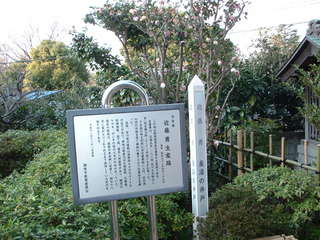(三鷹市にある、民俗文化財水車経営農家、の概要については10月2日からの20回で説明した。これからは、多少視野を広げ、折々に興味の引かれる問題について記述する)
This is a trial presentation for English speakers.
(The continuation of yesterday's artile)
Sieve and Conveyer
The flour produced by millstones is originally mixed grain flour with pieces of grain’s surface skins, or grain bran. The sieve, which is a wooden frame spread with silk nets, is used to separate these two materials with each other. The flour mixed with bran thrown onto nets of sieve is shaken by the back and forth motion of frame. And then, the smaller particles are fallen down into a pail lied under the net. The remainders on the nets are returned to the top of millstones by a set of conveyers in order to grind them by millstones again. The set of conveyers is a chain of baskets to scoop flour up and is also, of course, moved by the power from waterwheel.
The Japanese noodle called as‘Udon’is made of wheat flour.
Works of Gear
In present days, almost all of the gears existed around our daily life are made of iron or plastic. But in the past, the wooden gears were generally used for various machinery mechanisms.
All gears used for‘Shin-guruma’ were assembled from many wooden parts like each cog and rim in order to use them longer by exchanging only parts damaged. There were two roles of gear used in the waterwheel device; those are, to transfer power itself and to change power direction from one to another.
In comparison with the other waterwheel, one of the unique gears of ‘Shin-guruma’ is understood to be a double gear for pestle operation.
The way to produce rice flour
The millstones existing near the entrance of millhouse were used to produce rice and/or buckwheat flours. The top stone of the millstones, which lies on the bottom stone fixed and connected to waterwheel through gears and a shaft, rotates to grind grains in a gap between two stones. The flour grinded is lead to a sieve called as ‘Mangoku’, which separates grain flour from bran, or the breakages of grain surface cover, by means of sloping net.
Rolled Wheat Producing Equipment
In the past, the staple meal of Japanese farmer was not rice itself but the grains mixed 70% of wheat with 30% of rice because almost all rice produced were paid to lords as tax. On the other hand, it is difficult to eat wheat without any treatment because of its hard surface cover. Before the beginning of 20 century, the wheat particles broken by millstones had been eaten (‘Warimugi’ in Japanese). ‘Shin-guruma’ included a process to break wheat grains by ‘Kine’.
An equipment to produce rolled wheat (‘Oshimugi’ in Japanese) of which taste is better than the meal or broken wheat was introduced into the‘Shin-guruma’system in 1922. The power to operate it was not electric but still driven from existing waterwheel, or‘Shin-guruma’.
In this equipment, each wheat grain lead into the top bucket flows down to a gap between two iron drums and is flattened.
(To be suspended)
This is a trial presentation for English speakers.
(The continuation of yesterday's artile)
Sieve and Conveyer
The flour produced by millstones is originally mixed grain flour with pieces of grain’s surface skins, or grain bran. The sieve, which is a wooden frame spread with silk nets, is used to separate these two materials with each other. The flour mixed with bran thrown onto nets of sieve is shaken by the back and forth motion of frame. And then, the smaller particles are fallen down into a pail lied under the net. The remainders on the nets are returned to the top of millstones by a set of conveyers in order to grind them by millstones again. The set of conveyers is a chain of baskets to scoop flour up and is also, of course, moved by the power from waterwheel.
The Japanese noodle called as‘Udon’is made of wheat flour.
Works of Gear
In present days, almost all of the gears existed around our daily life are made of iron or plastic. But in the past, the wooden gears were generally used for various machinery mechanisms.
All gears used for‘Shin-guruma’ were assembled from many wooden parts like each cog and rim in order to use them longer by exchanging only parts damaged. There were two roles of gear used in the waterwheel device; those are, to transfer power itself and to change power direction from one to another.
In comparison with the other waterwheel, one of the unique gears of ‘Shin-guruma’ is understood to be a double gear for pestle operation.
The way to produce rice flour
The millstones existing near the entrance of millhouse were used to produce rice and/or buckwheat flours. The top stone of the millstones, which lies on the bottom stone fixed and connected to waterwheel through gears and a shaft, rotates to grind grains in a gap between two stones. The flour grinded is lead to a sieve called as ‘Mangoku’, which separates grain flour from bran, or the breakages of grain surface cover, by means of sloping net.
Rolled Wheat Producing Equipment
In the past, the staple meal of Japanese farmer was not rice itself but the grains mixed 70% of wheat with 30% of rice because almost all rice produced were paid to lords as tax. On the other hand, it is difficult to eat wheat without any treatment because of its hard surface cover. Before the beginning of 20 century, the wheat particles broken by millstones had been eaten (‘Warimugi’ in Japanese). ‘Shin-guruma’ included a process to break wheat grains by ‘Kine’.
An equipment to produce rolled wheat (‘Oshimugi’ in Japanese) of which taste is better than the meal or broken wheat was introduced into the‘Shin-guruma’system in 1922. The power to operate it was not electric but still driven from existing waterwheel, or‘Shin-guruma’.
In this equipment, each wheat grain lead into the top bucket flows down to a gap between two iron drums and is flattened.
(To be suspended)










